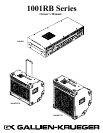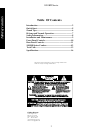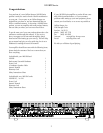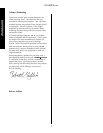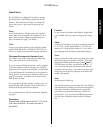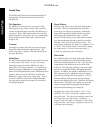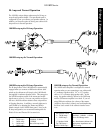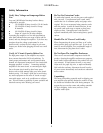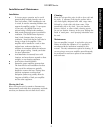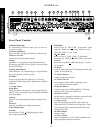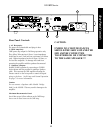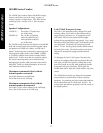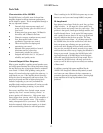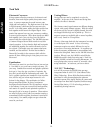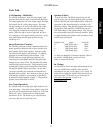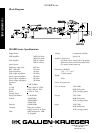
5
1001RB Series
Quick Start
The 1001RB Series is designed to be simple to operate.
All controls have a well defined purpose and are well
behaved. These directions will take you through the
basics and give you a good start for setting up your
sound.
First:
Set the power switch to Off and connect the supplied
power cable, from the amplifier AC receptacle, to an AC
power outlet of proper voltage and power rating (see
safety information on page 7 for details).
Next:
Connect your speaker cabinets to the amplifier outputs
marked 540W AMP ONLY or “SPEAKON” OUTPUTS. Be
sure not to exceed the recommended speaker load below.
Maximum Recommended Speaker Load:
One 4 Ohm, or two 8 Ohm cabinets on the 540W Amp.
One or two 8 Ohm horns on the 50W Amp.
If you are using an RBH Series cabinet, use the supplied
4 conductor Speakon cable to connect to the “Speakon”
outputs on the rear panel of the amplifier. Set the Woofer
X-Over and Tweeter Hi Cut switches on the front panel to
the IN position. You may want to adjust these later as you
optimize your sound. In addition, set the switch on the
RBH cabinet to Bi-Amp.
For connection to all other cabinets, connect to the 1/4”
outputs labeled 540W amp only. Set the Woofer X-Over
switch on the front panel to the Out position.
For more information on Bi-Amp and Normal Operation,
see page 7.
Remember:
Playing loud with the master below 12 O clock
will cause distortion. In some cases this is
desireable.
Caution:
Do not connect the Speakon cable labeled “Bridge Mode”
to the 1001RB. This may result in damage to the ampli-
fier.
Then:
Set all the voicing filters’ EQ controls and the Boost control
to 12 o’clock. Set the Woofer/Master to 3 O’ Clock, the
tweeter to 12 O’clock and the volume to 0. If you have a
five string bass, push the button marked String Bass in.
Next:
Using an instrument cable, connect your bass to the Input
jack and turn the power switch on and play. If the input
clipping LED flashes, push the button marked in.
This will prevent you from overdriving the preamp. If
you have a bass with passive electronics make sure the
controls are all the way up. If you have a bass with active
electronics, turn all of the EQ controls on the bass to the
middle or flat position.
Now:
Slowly bring the Volume up.
You should be hearing your bass quite well. Your amplifier
and instrument are currently set in their nominal position.
From this point further adjustment may be required to
accomodate your particular instrument, cabinet and
playing styles. If you are using and RBH Bi-Amp cabinet
you may want to adjust the tweeter control for balance
first.
Quick Start



